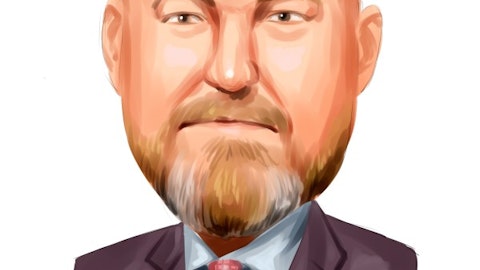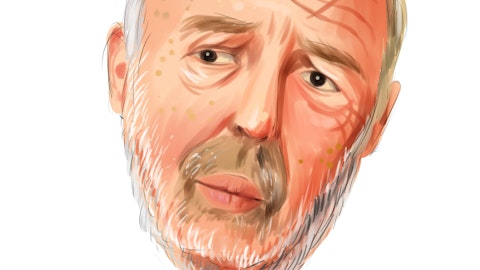Federal Agricultural Mortgage Corporation (NYSE:AGM) Q1 2023 Earnings Call Transcript May 9, 2023
Operator: Good afternoon, and welcome to the Farmer Mac First Quarter 2023 Earnings Call. All participants will be in listen-only mode. Please note that, this event is being recorded. I would now like to turn the conference over to Jalpa Nazareth, Senior Director of Investor Relations. Please go ahead.
Jalpa Nazareth: Good afternoon and thank you for joining us for our first quarter 2023 earnings conference call. I’m Jalpa Nazareth, Senior Director of Investor Relations and Finance Strategy here at Farmer Mac. As we begin, please note that the information provided during this call may contain forward-looking statements about the company’s business, strategies and prospects which are based on management’s current expectations and assumptions. These statements are not a guarantee of future performance and are subject to risks and uncertainties that could cause our actual results to differ materially from those projected. Please refer to Farmer Mac’s 2022 Annual Report and subsequent SEC filings for a full discussion of the company’s risk factors.
On today’s call, we will also be discussing certain non-GAAP financial measures. Disclosures and reconciliations of these non-GAAP measures can be found in the most recent Form 10-Q and earnings release posted on Farmer Mac’s website farmermac.com under the Financial Information portion of the Investors section. Joining us from management this afternoon are our President and CEO, Brad Nordholm, who will discuss first quarter business and financial highlights and strategic objectives; and Chief Financial Officer, Aparna Ramesh, who will provide greater detail on our financial performance. Select members of our management team will also be joining us for the question-and-answer period. At this time, I’ll turn the call over to President and CEO, Brad Nordholm.
Brad?
Brad Nordholm: Thanks, Jalpa, and good afternoon, everyone. Thanks for joining us today. I’m very pleased to announce we delivered a great quarter with new all-time records for revenue, earnings, and net effective spread, and all-time records in the growth rates of these three metrics. Our results not only highlight the resiliency of our business model, our disciplined approach to asset liability management and our successful efforts over the last few years to grow and diversify our revenue streams, but also the alignment of our team with our long-term strategic objectives and passion for fulfillment of our mission throughout changing market cycles. For some time, Aparna and I have talked with you about our disciplined approach to asset liability management.
We’ve emphasized that our ability to issue long-dated fixed rate debt in all rate environments and economic cycles is a core competitive advantage that when combined with our approach to asset liability management, helps to produce consistent spreads and provides remarkable forward visibility to future earnings. The recent volatility in the capital markets and failures of depository institutions provide a stark contrast between Farmer Mac and banks. We’re not a bank and we don’t rely upon deposits as a source of funding. The terms governing our debt securities are contractual in nature, and we, not depositors, hold the optionality of when and how to call our debt. We will continue to talk about these differences and why Farmer Mac’s business model is resilient and has the ability to deliver such consistent results.
In the first quarter of 2023, we booked core earnings of $38.9 million, a 50% increase over the same period one year ago. We provided a gross $1.7 billion in liquidity and lending capacity to lenders serving rural America, resulting in total outstanding business volume growth of over $500 million from year end to $26.5 billion as of March 31, 2023, which annualized is about a 7.5% growth rate. The volume growth this quarter was primarily attributable to the efforts we’ve made over the last few years to diversify our business model across numerous key markets. We achieved $608 million of net new business in Rural Infrastructure. We acquired nearly $100 million in telecommunication loans in the first quarter of 2023 as there is growing investment in fiber and broadband in rural America.
These telco assets are highly accretive in terms of NES and are another reflection of our attempts to diversify our asset portfolio. We remain committed to increase investment in the telecommunication and broadband sectors, which are highly mission-centric, and we look forward to providing additional updates on this new avenue of growth for Farmer Mac. Our Renewable Energy portfolio also experienced a strong start to the year with approximately $80 million in net growth from several counterparties. Our participation in broadly syndicated renewable energy transactions has increased the number of potential counterparties to source transactions from in-future years. The pipeline remains strong and near future as we continue to focus on upsizing existing deals and bring on new renewable energy opportunities with additional resources committed to this area.
Outstanding volume in Agricultural Finance line of business was relatively flat from year end, largely due to continued economic uncertainty and broader market volatility. We do see opportunities to help our customers with their liquidity needs as they navigate the recent disruptions in the banking industry. Borrowers in the Farm & Ranch segment declined sequentially due to two reasons. The first is the seasonally large number of scheduled payments due to the majority of the Farm & Ranch loan customers which are annual or semiannual, with payments falling on January 1st of the year. The second is that many of those borrowers during that period of time are focused on the renewal of existing lines of credit ahead of the spring planting season.
Outstanding volume in our Corporate AgFinance portfolio was relatively flat from year end, as persistent volatility and uncertainty in the market slowed down deal opportunities in the first quarter with many transactions on pause, waiting for signs of stabilization in the macroeconomic outlook. When we spoke to current and prospective institutional customers during the recent Global Ag Investing Conference in New York, we heard a recurring theme that there was a large balance of institutional money ready to be put to work in a cultural space. In recent weeks, we have also seen more opportunities to continue to be creative from a net effective spread standpoint. We remain focused on this sector. It’s a key component of our diversification strategy, central to our mission and impactful of earnings and continued growth.

Pixabay/Public Domain
We told you about our successful execution of our third securitization in February of this year on our call, and we’ve continued to receive excellent market feedback, as well as demand for agricultural backed securitization products. This program aligns very well with our core mission, to lower our costs for our end borrowers, and improve credit availability in rural America. We remain committed to being a regular issuer in the securitization market. It’s now become routine for us with a set of securitization products that align with borrower and investor interest. Looking ahead, our underlying business model, our strong capital position, and our uninterrupted access to debt capital markets throughout the various market disruptions, uniquely positions us to partner with our customers to help them manage their business and the risks they face around future capital requirements and liquidity.
The foundation of our strategy is our consistent financial and operational execution, coupled with proactive management of our balance sheet, and funding sources, which has and we expect will position us well in changing credit environments, and create more opportunities to enhance shareholder value and fulfill our mission. Now, I’ll turn the call over to Aparna Ramesh, our Chief Financial Officer to discuss the results in more detail. Aparna?
Aparna Ramesh: Thank you, Brad. And good afternoon, everyone. Our record first quarter 2023 results highlight a balanced, well measured approach, continuing strong credit quality and resiliency across market cycles. We achieved $1.7 billion of new business volume this quarter. And some of the key components include: $500 million in Rural Infrastructure AgVantage bonds; $145 million in gross corporate Agricultural Finance loan purchases, which is about 135% higher than last year at this time; and $73 million in gross Renewable Energy loan purchases. After repayments, we grew about $600 million this quarter in our outstanding business volume and this speaks to the benefit of our diversified portfolio. And notably there has been strong execution in our Rural Infrastructure line of business.
Core earnings were $38.9 million or $3.56 per share in the first quarter of 2023. And this reflects, as Brad noted, a 50% year-over-year growth that’s driven by record net effective spread of $77.2 million in the first quarter of 2023 compared to $57.8 million in the same period last year. As Brad highlighted, despite the earnings pressure that many financial institutions are currently facing, our net effective spread this quarter increased appreciably, and was at 115 basis points. This was primarily driven by significant reduction in our cost of borrowing and strong pricing in the rural infrastructure sector. Despite short-term interest rates peaking, our cost of funds have trended systematically downward. This is because of our disciplined asset liability management practices, where we hedged our risk effectively, while changing our funding mix to take advantage of opportunities as the yield curve changed.
Another significant driver of the lower cost of funds is from the low cost of debt and capital that we raised opportunistically, when rates were at historical lows in 2020 and 2021. These decisions have continued to pay-off as we have reduced the need for us to raise more expensive term and callable debt in a rising rate environment. This benefit is expected to continue to create a downward pressure on our non-GAAP funding costs as the short end of the curve continues to increase with Fed actions and the reinvesting of excess capital generates additional return with an upward repricing of our short-term investment portfolio. While the rise in short-term interest rates has provided an asymmetric benefit to earnings, we project limited downside to earnings when rates decline.
The reason for this is that we expect to retain some of this benefit over the medium-term if rates were to decline as we have proactively started extending maturities in our investment portfolio. Again, these are all practices and are an example that are consistent with our disciplined approach that’s designed to help minimize earnings volatility. Brad highlighted important differences our business model and those of traditional depository institutions. In the wake of the banking crisis, we voluntarily conducted a review of our own asset liability management practices. The results of this review highlighted that our disciplined hedging strategy where we match the duration and convexity of our assets and liabilities in all rate environments have significantly contained earning volatility.
Our liquidity and capital position are well in excess of all regulatory ratios and our projections show minimal change in our profitability and market value, regardless of the direction and size of any rate shock that we might apply to stress our balance sheet. We highlighted improvement in pricing in the Rural Utilities segment, which has also been a contributor to the higher NES in the first quarter of 2023. This was driven by higher spread volumes related to the telecommunications sector and this sector has nearly doubled year-over-year to $356 million as of March 31, 2023. This increase was slightly offset by flat to lower pricing in the Agricultural Finance line of business that stem from increased competition for high-quality credits and limited loan origination in the sector.
However, we are seeing opportunities ahead though for us to partner with our customers, especially as rate increases dig into deeper. Turning to operating expenses. These have increased by 11% year-over-year and that’s been primarily due to the full year compensation impact of new hires that were gradually brought on board throughout 2022 and the initial expenditure in the first quarter that’s been associated with the multiyear technology investment in our Treasury and cash management systems to enhance our trading, hedging and reporting platforms. This modernization effort is expected to position us to be defensive against cyber and fraud threats in the future, and also allow us to scale our portfolio and diversify our product offerings. We expect our run rate operating expenses to increase at a pace above historical averages over the next several years, given our plans to continue to make investments in our team and our infrastructure to support our growth and strategic objectives.
As of March 31, 2023, our operating efficiency was 28% and below our strategic plan target of 30%. And that’s primarily because revenue growth increased at a significantly higher rate than expense growth. We will, however, continue to closely monitor our efficiency ratio. As we invest in loan infrastructure and funding platforms and innovate our loan processes to accelerate growth, we do expect to see some temporary increases that could go above the 30% level. Our credit profile is holding strong in aggregate, despite the economic headwinds. While 90-day delinquencies increased $27 million sequentially to $71 million or 27 basis points of our entire portfolio, it was primarily due to $16 million in permanent planting loans that are attributable to a single borrower that became delinquent in first quarter of 2023.
This increase is in line with the seasonal rise consistently observed during the first quarter and related to the January 1 payment date on most of our portfolio. As of March 31, 2023, the total allowance for losses was $17.9 million, reflecting an $800,000 increase from year-end 2022. The increase was primarily attributable to a single agricultural storage and processing zone. The borrower is currently undergoing bankruptcy proceeding. We expect this situation to be resolved in the next several months. Now turning to capital. Farmer Mac’s $1.4 billion of core capital as of March 31, 2023, exceeded our statutory requirement by $534 million or 65%. Core capital increased from year-end 2022, but primarily due to an increase in retained earnings.
Our Tier 1 capital ratio improved to 15.7% as of March 31, 2023, from 14.9% as of year-end 2022, largely as noted, due to strong earnings results, as well as the reduction in risk-based capital consumption that occurred from our third securitization transaction. Maintaining credit standards that reflect our risk profile, coupled with strong levels of capital is extremely fundamental to our long-term strategy. During our last earnings call in February, we discussed the successful execution of our third $300 million securitization transaction in evolving and difficult market conditions. This has created a well-received new investment opportunities for leading institutional investors. But I’d also like to highlight that this is just another example of our diversified sources of funding.
In conclusion, our entire team delivered exceptional quarterly results, surpassing the key metrics that we highlight on each call. Notably, we delivered an 18% return on equity, and an efficiency ratio of 28%. We believe that our balance sheet is well positioned for uncertainty, and we’re more optimistic than ever to deliver on our long-term strategic plan objectives. And with that, Brad, let me turn it back to you.
Brad Nordholm: Thanks, Aparna. We experienced a strong start to 2023, despite the backdrop of economic uncertainty and market volatility. I am extremely proud of our team and the excellent progress that we are making on our multiyear strategic initiatives. We believe we are well positioned to deliver strong financial performance and consistent returns to our shareholders over the rest of 2023, even though there is uncertainty in the economy. And now operator, I’d like to see if we have any questions from anyone on the line with us today.
See also 15 Best Interest Yielding Checking Accounts in the US and 13 Best Consulting Stocks to Buy Now.
Q&A Session
Follow Federal Agricultural Mortgage Corp (NYSE:AGM)
Follow Federal Agricultural Mortgage Corp (NYSE:AGM)
Operator: Our first question comes from Bill Ryan from Seaport Research Partners.
William Ryan: First one for Brad. You mentioned the regional banking crisis a few times in your early commentary. And I was wondering if you’re seeing any additional inquiries coming in about potentially additional volume coming your way as banks might be looking to let’s just say increase their liquidity positions or capital levels?
Brad Nordholm: Yes, Bill, we are paying a lot of attention to that and there are two potential ways and I emphasize potential ways that, that can occur. There may be banks that hold portfolio of loans that otherwise they might have sold to us in the past, that now they’re ready to sell. Just for a very simple example, Silicon Valley Bank had approximately 700 and some odd million dollars of first mortgage loans on vineyards in California. So, that’s slowly working its way through receivership. But we’ll keep an eye on that and other similar situations, as well as those banks that may hold portfolios like that, that are feeling under capital pressure today. The second way that it can arise is the banks that in the past may have had a bias towards doing a three or five or seven year first mortgage loan and arm, and holding on our balance sheet.
And today, a couple things are working against them. One, they may be having liquidity and capital constraints that they weren’t experiencing six to 12 months ago. And the others with the shape of the yield curve. It really favors longer term fixed rate debt where we have an advantage in funding, especially in comparison to bank that is dependent on deposits. So it hasn’t — those two opportunities haven’t been reflected in the numbers yet. And it’s very difficult to project to what extent they may be reflected in future numbers. But we’re keeping a close eye on it. And just common sense tells us that yes, there should be some additional opportunities coming because of that. Now, there’s still a headwind out there, particularly for first mortgage loans for the Farm & Ranch program of very few refinancings and higher overall interest rates having a kind of depressing or stifling effect on new origination.
But these two factors that I just mentioned provide a bit of a tailwind for us and should provide some additional opportunity through the remainder of the year.
William Ryan: Okay. And one follow-up on the finance business. You mentioned it last quarter that it was kind of a little bit log-jammed, given the disruption in the capital markets, you kind of echoed that comment again this quarter. What’s it going to take to kind of free up the volume that’s kind of like sitting there ready to go?
Brad Nordholm: Well, right now, a higher portion of the first mortgage loan Farm & Ranch opportunities are going to be associated with the transfer of real estate. And you can read some of our publications, The Feed and others and our Chief Economist, Jackson Takach commenting on land values, which have held up remarkably well. So you apply higher interest rates to already high land values and you have a higher cost to carry of more challenging kind of economic value proposition. So we are not seeing a big increase in the transfer of land that is motivating new financing opportunities. But I would draw your attention, Bill, back to our comments and our presentation of our numbers across all of our segments. And while Farm & Ranch is, we have noted now, both in our formal comments and I’ve also noted them just now, while it’s down for Farm & Ranch, our volumes for some of our rural infrastructure and specifically telecom, rural utility and renewable energy project finance are up.




